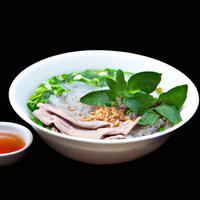
1 serving (100 grams) contains 120 calories, 3.0 grams of protein, 1.0 grams of fat, and 25.0 grams of carbohydrates.

Log this food in SnapCalorie

Nutrition Information
Calories |
285.7 | ||
|---|---|---|---|
% Daily Value* |
|||
| Total Fat | 2.4 g | 3% | |
| Saturated Fat | 0.5 g | 2% | |
| Polyunsaturated Fat | 0 g | ||
| Cholesterol | 0 mg | 0% | |
| Sodium | 23.8 mg | 1% | |
| Total Carbohydrates | 59.5 g | 21% | |
| Dietary Fiber | 2.4 g | 8% | |
| Sugars | 0 g | ||
| protein | 7.1 g | 14% | |
| Vitamin D | 0 mcg | 0% | |
| Calcium | 23.8 mg | 1% | |
| Iron | 1.2 mg | 6% | |
| Potassium | 47.6 mg | 1% | |
* Percent Daily Values are based on a 2,000 calorie diet. Your daily values may be higher or lower depending on your calorie needs.
Food Attributes
Source of Calories
About Pho noodle
Pho noodle is a staple of Vietnamese cuisine, traditionally served in a flavorful broth accompanied by proteins like beef or chicken, and garnished with fresh herbs, lime, and chili peppers. The noodles are made from rice, offering a gluten-free option for those with sensitivities. Packed with fresh ingredients, pho delivers a balance of nutrients. The broth, often simmered with bones and aromatics, provides a source of protein and minerals while its low-fat content makes it a healthy choice when compared to cream-based soups. The addition of herbs like cilantro and basil contributes antioxidants and essential vitamins. However, the sodium levels in pho can be high depending on the preparation, especially with store-bought or restaurant versions. By customizing your bowl with lean protein, reduced-sodium broth, and ample vegetables, pho can be transformed into a nourishing, well-rounded meal ideal for anyone seeking a wholesome taste of Vietnamese culture.



